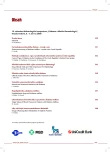Potential New Antidiabetics for the Next Decade
Authors:
Š. Svačina
Authors‘ workplace:
III. interní klinika 1. lékařské fakulty UK a VFN Praha, přednosta prof. MUDr. Štěpán Svačina, DrSc., MBA
Published in:
Vnitř Lék 2009; 55(4): 429-433
Category:
Overview
In the next 10 years, major changes in the pharmacotherapy of diabetes can be expected. Both the currently used groups of drugs classified as dipeptidyl-peptidase IV blockers (gliptins) and so-called incretin mimetics (including both natural substances and incretin analogues) will be significantly expanded by up to ten new drugs. In addition, other completely new groups of drugs that act, for instance, via the hepatal mechanism or by influencing the metabolism of steroids will appear. Blocking the absorption of glucose in renal tubules by gliflozines seems to be very promising. In the treatment of diabetes complications, the inhibition of protein kinase C will probably mostly be applied. So-called insulinotropic peptides will very likely be applied by injection and substances reducing insulin resistance as well as new types of substances influencing PPAR nuclear receptors will be administered. In diabetology, antibodies against receptors will be used, too. However, modern pharmacotherapy will undoubtedly come up against the principles of so-called metabolic surgery and other successful technological procedures.
Key words:
dipeptidase IV blockers – incretin mimetics – antidiabetics with hepatal effect – insulinotropic peptides – gliflozines – metabolic surgery
Sources
1. Šmahelová A. Gliptiny – nová skupina léčiv v diabetologii. Farmakoterapie 2008; 3 : 347–350.
2. Svačina Š, Doležal T. Exenatid. Farmakoterapie 2008; 3 : 291–295.
3. Šmahelová A. Liraglutid. Farmakoterapie 2008; 3 : 260–264.
4. Haluzík M, Svačina Š. Blokátory dipeptidyl peptidázy 4 (gliptiny) v léčbě diabetes mellitus 2. typu. Trendy v diabetologii 12. Praha: Galén 2008 : 203–221.
5. Nauck M, Frid A, Hermansen K et al. LEAD-2 Study Group. Efficacy and safety comparison of liraglutide, glimepiride, and placebo, all in combination with metformin, in type 2 diabetes: the LEAD (liraglutide effect and action in diabetes-2 study). Diabetes Care 2009; 32 : 84–90.
6. Green BD, Flatt PR. Incretin hormone mimetics and analogues in diabetes therapeutics. Best Pract Clin Endocrinol Metab 2007; 21 : 497–516.
7. Kim D, MacConell L, Zhuang D et al. Effects of once‑weekly dosing of a long‑acting release formulation of exenatide on glucose control and body weight in subjects with type 2 diabetes. Diabetes Care 2007; 30 : 1487–1493.
8. Perry TA, Greig NH. A new Alzheimer’s disease interventive strategy: GLP‑1. Curr Drug Targets 2004; 5 : 565–571.
9. Han S, Hagan DL, Taylor JR et al. Dapagliflozin, a selective SGLT2 inhibitor, improves glucose homeostasis in normal and diabetic rats. Diabetes 2008; 57 : 1723–1729.
10. Isaji M. Sodium-glucose cotransporter inhibitors for diabetes. Curr Opin Investig Drugs 2007; 8 : 285–292.
11. Clarke M, Dodson PM. PKC inhibition and diabetic microvascular complications. Best Pract Clin Endocr Metab 2007; 21 : 573–586.
12. Agius L. New hepatic targets for glycaemic control in diabetes. Best Pract Clin Endocrinol Metab 2007; 21 : 587–605.
13. Tomlinson JW, Stewart PM. Modulation of glucocorticoid action and the treatment of type-2 diabetes. Best Pract Clin Endocrinol Metab 2007; 21 : 607–619.
14. Koren S, Fantus IG. Inhibition of the protein tyrosine phosphatase PTP1B: potential therapy for obesity, insulin resistance and type-2 diabetes mellitus. Best Pract Clin Endocrinol Metab 2007; 21 : 621–640.
15. Billyard T, McTernan P, Kumar S. Potential therapies based on antidiabetic peptides. Best Pract Clin Endocrinol Metab 2007; 21 : 641–655.
16. Dray C, Knauf C, Daviaud D et al. Apelin stimulates glucose utilization in normal and obese insulin‑resistant mice. Cell Metab 2008; 8 : 437–445.
17. Gross B. Staels B. PPAR agonists: multimodal drugs for the treatment of type-2 diabetes. Best Pract Clin Endocrinol Metab 2007; 21 : 687–710.
18. Svačina Š. Nové formy inzulinoterapie. Trendy v diabetologii 10. Praha: Galén 2005 : 211–220.
19. Svačina Š. Nové trendy ve farmakoterapii obezity. Farmakoterapie 2005; 4 : 300–301.
20. Svačina Š, Matoulek M, Jiráčková L. Potravinové doplňky v diabetologii. Trendy v diabetologii 12. Praha: Galén 2008 : 133–151.
21. Fried M, Svačina Š, Owen K. Bariatrická chirurgie a diabetes. Trendy v diabetologii 10. Praha: Galén 2005 : 169–210.
22. Nathan DM, Buse JB, Davidson MB et al. American Diabetes Association; European Association for Study of Diabetes. Medical management of hyperglycemia in type 2 diabetes: a consensus algorithm for the initiation and adjustment of therapy: a consensus statement of the American Diabetes Association and the European Association for the Study of Diabetes. Diabetes Care 2009; 32 : 193–203.
23. Svačina Š. Prevence diabetu a jeho komplikací. Praha: Triton 2008.
24. Larsen CM, Faulenbach M, Vaag A et al. Interleukin‑1-receptor antagonist in type 2 diabetes mellitus. N Engl J Med 2007; 356 : 1517–1526.
Labels
Diabetology Endocrinology Internal medicineArticle was published in
Internal Medicine

2009 Issue 4
Most read in this issue
- Target Values of Blood Pressure in Patients with Diabetes Mellitus
- Options of Hormonal Contraceptives and Substitution in Female Diabetic Patients
- Drug Interactions of Selected Drugs Used by Patients with Diabetes Mellitus
- Insulin Sensitizing Drugs
